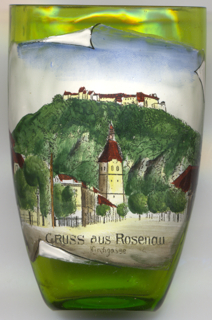

|
| ROMÂNIA | ROMANIA |
| județ Brașov | Brașov County |
Râșnov (German: Rosenau, Hungarian: Barcarozsnyó) is situated at an elevatsion of 635 m on the creek Ghimbășel in the southeast of the Transilvania, about 18 km southwest of the district town Brașov. The municipality has a population of about 15,000 (2011).
The castle of Râșnov was probably built in the years 1211–1225 by Teutonic Knights. Râșnov was mentioned for the first time in 1331 as Rosnou and again in 1388 as villa Rosarum. While the village was razed many times in its history by Tatars, Turks and Wallachians, the castle was conquered only once, in 1612 by Gabriel Báthory, Prince of Transilvania.

 Râșnov citadel [background top] was built as part of a defence
system for the Transylvanian villages exposed to outside invasions. The only chance of survival for the inhabitants of the
area was the refuge inside the citadel at Râșnov. Compelled to stay there for decades, the people of
Râșnov and the nearby villages turned the fortification into a long-term place of residence. The medieval
fortress of today is considered to be built between 1211 and 1225, during the rule of the Teutonic Knights in Burzenland,
although there is no evidence in this respect. In 1335, during a Tatar incursion that ravaged Burzenland, Râșnov
and Brașov were the only fortified places remaining unconquered. This is also the first
documented attestation of the fortress. The fortress was conquered only once, during the rule of Prince Gabriel
Báthory, in 1612. The fall was caused by the lack of water due to the discovery of the path to a secret spring by the
enemy troops. To remove the weakness constituted by the lack of a source of water inside the fortress, a 146 metres
deep well was dug out between 1623 and 1642.In 1718 the fortress was partially destroyed by a fire, and in 1802 it was
damaged by an earthquake. In 1850, due to the diminution of the fortress's defensive role, the fortress was abandoned,
becoming a ruin. After the two world wars and the takeover of the communist regime in Romania, the fortress was restored for
the first time in the years 1955–1956.
Râșnov citadel [background top] was built as part of a defence
system for the Transylvanian villages exposed to outside invasions. The only chance of survival for the inhabitants of the
area was the refuge inside the citadel at Râșnov. Compelled to stay there for decades, the people of
Râșnov and the nearby villages turned the fortification into a long-term place of residence. The medieval
fortress of today is considered to be built between 1211 and 1225, during the rule of the Teutonic Knights in Burzenland,
although there is no evidence in this respect. In 1335, during a Tatar incursion that ravaged Burzenland, Râșnov
and Brașov were the only fortified places remaining unconquered. This is also the first
documented attestation of the fortress. The fortress was conquered only once, during the rule of Prince Gabriel
Báthory, in 1612. The fall was caused by the lack of water due to the discovery of the path to a secret spring by the
enemy troops. To remove the weakness constituted by the lack of a source of water inside the fortress, a 146 metres
deep well was dug out between 1623 and 1642.In 1718 the fortress was partially destroyed by a fire, and in 1802 it was
damaged by an earthquake. In 1850, due to the diminution of the fortress's defensive role, the fortress was abandoned,
becoming a ruin. After the two world wars and the takeover of the communist regime in Romania, the fortress was restored for
the first time in the years 1955–1956.
The Protestant  church of St. Matthias [centre] was built in the
13th/14th century as a basilica in a transition style from the Romanesque to the Gothic style. Around 1452–1453
most of the local Saxon community adopted the Lutheran faith. Most of the altars and other objects bearing images of
saints were removed and the mural paintings from the 14th/16th century were painted over (parts of it were rediscovered
in 1932). The church was rebuilt in part in 1773, and following an earthquake in 1802, the vaulting of the central nave
was rebuilt in the following year. During a fie in 1718, three bells melted and were replaced in 1720. The church was
remodeled in Baroque style in 1774–1775. The last restoration was carried out in 1839 following another earthquake
that had damaged the church a year earlier.
church of St. Matthias [centre] was built in the
13th/14th century as a basilica in a transition style from the Romanesque to the Gothic style. Around 1452–1453
most of the local Saxon community adopted the Lutheran faith. Most of the altars and other objects bearing images of
saints were removed and the mural paintings from the 14th/16th century were painted over (parts of it were rediscovered
in 1932). The church was rebuilt in part in 1773, and following an earthquake in 1802, the vaulting of the central nave
was rebuilt in the following year. During a fie in 1718, three bells melted and were replaced in 1720. The church was
remodeled in Baroque style in 1774–1775. The last restoration was carried out in 1839 following another earthquake
that had damaged the church a year earlier.
Rosenau, the former German name of Râșnov, also was the former German name of Rožnov pod Radhoštěm, Czech Republic. Another glass in this collection is from Rosenau, Austria.
[https://de.wikipedia.org/wiki/Râșnov, https://en.wikipedia.org/wiki/Râșnov;
https://en.wikipedia.org/wiki/Râșnov_Citadel;
https://ro.wikipedia.org/wiki/Biserica_evanghelică_din_Râșnov]
![[scale]](lineal.jpg)